July 2027 lunar eclipse
Astronomical event From Wikipedia, the free encyclopedia
A penumbral lunar eclipse will occur at the Moon’s ascending node of orbit on Sunday, July 18, 2027,[1] with an umbral magnitude of −1.0662. A lunar eclipse occurs when the Moon moves into the Earth's shadow, causing the Moon to be darkened. A penumbral lunar eclipse occurs when part or all of the Moon's near side passes into the Earth's penumbra. Unlike a solar eclipse, which can only be viewed from a relatively small area of the world, a lunar eclipse may be viewed from anywhere on the night side of Earth. Occurring only about 16 hours before apogee (on July 19, 2027, at 7:50 UTC), the Moon's apparent diameter will be smaller.[2]
| Penumbral eclipse | |||||||||
 The Moon's hourly motion shown right to left | |||||||||
| Date | July 18, 2027 | ||||||||
|---|---|---|---|---|---|---|---|---|---|
| Gamma | −1.5759 | ||||||||
| Magnitude | −1.0662 | ||||||||
| Saros cycle | 110 (72 of 72) | ||||||||
| Penumbral | 11 minutes, 47 seconds | ||||||||
| |||||||||
The Moon will barely clip the edge of the Earth's penumbral shadow, and the eclipse will be impossible to see in practice. The event is listed as a miss by some sources.[3]
Visibility
The eclipse will be completely visible over Asia, east Africa, and Australia.[4]
  |
Eclipse details
Shown below is a table displaying details about this particular eclipse. It describes various parameters pertaining to this eclipse.[5]
| Parameter | Value |
|---|---|
| Penumbral Magnitude | 0.00320 |
| Umbral Magnitude | −1.06620 |
| Gamma | −1.57589 |
| Sun Right Ascension | 07h51m14.4s |
| Sun Declination | +20°58'43.6" |
| Sun Semi-Diameter | 15'44.3" |
| Sun Equatorial Horizontal Parallax | 08.7" |
| Moon Right Ascension | 19h52m57.2s |
| Moon Declination | -22°20'25.3" |
| Moon Semi-Diameter | 14'43.0" |
| Moon Equatorial Horizontal Parallax | 0°54'00.6" |
| ΔT | 72.7 s |
Eclipse season
This eclipse is part of an eclipse season, a period, roughly every six months, when eclipses occur. Only two (or occasionally three) eclipse seasons occur each year, and each season lasts about 35 days and repeats just short of six months (173 days) later; thus two full eclipse seasons always occur each year. Either two or three eclipses happen each eclipse season. In the sequence below, each eclipse is separated by a fortnight. The first and last eclipse in this sequence is separated by one synodic month.
| July 18 Ascending node (full moon) | August 2 Descending node (new moon) | August 17 Ascending node (full moon) |
|---|---|---|
 |  |  |
| Penumbral lunar eclipse Lunar Saros 110 | Total solar eclipse Solar Saros 136 | Penumbral lunar eclipse Lunar Saros 148 |
Related eclipses
Summarize
Perspective
Eclipses in 2027
- An annular solar eclipse on February 6.
- A penumbral lunar eclipse on February 20.
- A penumbral lunar eclipse on July 18.
- A total solar eclipse on August 2.
- A penumbral lunar eclipse on August 17.
Metonic
- Followed by: Lunar eclipse of May 7, 2031
Tzolkinex
- Preceded by: Lunar eclipse of June 5, 2020
Half-Saros
- Preceded by: Solar eclipse of July 13, 2018
- Followed by: Solar eclipse of July 23, 2036
Tritos
- Preceded by: Lunar eclipse of August 18, 2016
- Followed by: Lunar eclipse of June 17, 2038
Lunar Saros 110
- Preceded by: Lunar eclipse of July 7, 2009
Inex
- Preceded by: Lunar eclipse of August 8, 1998
- Followed by: Lunar eclipse of June 27, 2056
Triad
- Followed by: Lunar eclipse of May 19, 2114
Lunar eclipses of 2027–2031
This eclipse is a member of a semester series. An eclipse in a semester series of lunar eclipses repeats approximately every 177 days and 4 hours (a semester) at alternating nodes of the Moon's orbit.[6]
The penumbral lunar eclipses on February 20, 2027 and August 17, 2027 occur in the previous lunar year eclipse set, and the penumbral lunar eclipses on May 7, 2031 and October 30, 2031 occur in the next lunar year eclipse set.
| Lunar eclipse series sets from 2027 to 2031 | ||||||||
|---|---|---|---|---|---|---|---|---|
| Ascending node | Descending node | |||||||
| Saros | Date Viewing |
Type Chart |
Gamma | Saros | Date Viewing |
Type Chart |
Gamma | |
| 110 | 2027 Jul 18 |
Penumbral |
−1.5759 | 115 | 2028 Jan 12 |
Partial |
0.9818 | |
| 120 | 2028 Jul 06 |
Partial |
−0.7904 | 125 | 2028 Dec 31 |
Total |
0.3258 | |
| 130 | 2029 Jun 26 |
Total |
0.0124 | 135 | 2029 Dec 20 |
Total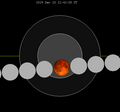 |
−0.3811 | |
| 140 | 2030 Jun 15 |
Partial |
0.7535 | 145 | 2030 Dec 09 |
Penumbral |
−1.0732 | |
| 150 | 2031 Jun 05 |
Penumbral |
1.4732 | |||||
Saros 110
This eclipse is a part of Saros series 110, repeating every 18 years, 11 days, and containing 72 events. The series started with a penumbral lunar eclipse on May 28, 747 AD. It contains partial eclipses from August 23, 891 AD through April 18, 1288; total eclipses from April 29, 1306 through September 5, 1522; and a second set of partial eclipses from September 16, 1540 through April 22, 1883. The series ends at member 72 as a penumbral eclipse on July 18, 2027.
The longest duration of totality was produced by member 38 at 103 minutes, 8 seconds on July 3, 1414. All eclipses in this series occur at the Moon’s ascending node of orbit.[7]
| Greatest | First | |||
|---|---|---|---|---|
| The greatest eclipse of the series occurred on 1414 Jul 03, lasting 103 minutes, 8 seconds.[8] | Penumbral | Partial | Total | Central |
| 747 May 28 |
891 Aug 23 |
1306 Apr 29 |
1360 May 31 | |
| Last | ||||
| Central | Total | Partial | Penumbral | |
| 1468 Aug 04 |
1522 Sep 05 |
1883 Apr 22 |
2027 Jul 18 | |
Eclipses are tabulated in three columns; every third eclipse in the same column is one exeligmos apart, so they all cast shadows over approximately the same parts of the Earth.
| Series members 60–72 occur between 1801 and 2027: | |||||
|---|---|---|---|---|---|
| 60 | 61 | 62 | |||
| 1811 Mar 10 | 1829 Mar 20 | 1847 Mar 31 | |||
| 63 | 64 | 65 | |||
| 1865 Apr 11 | 1883 Apr 22 | 1901 May 03 | |||
 |
 | ||||
| 66 | 67 | 68 | |||
| 1919 May 15 | 1937 May 25 | 1955 Jun 05 | |||
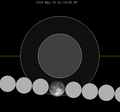 |
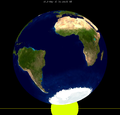 |
 |
 |
 |
 |
| 69 | 70 | 71 | |||
| 1973 Jun 15 | 1991 Jun 27 | 2009 Jul 07 | |||
 |
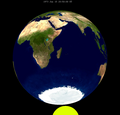 |
 |
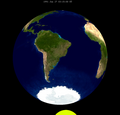 |
 |
 |
| 72 | |||||
| 2027 Jul 18 | |||||
 |
 | ||||
Tritos series
This eclipse is a part of a tritos cycle, repeating at alternating nodes every 135 synodic months (≈ 3986.63 days, or 11 years minus 1 month). Their appearance and longitude are irregular due to a lack of synchronization with the anomalistic month (period of perigee), but groupings of 3 tritos cycles (≈ 33 years minus 3 months) come close (≈ 434.044 anomalistic months), so eclipses are similar in these groupings.
| Series members between 1940 and 2200 | |||||||||
|---|---|---|---|---|---|---|---|---|---|
| 1940 Mar 23 (Saros 102) |
1951 Feb 21 (Saros 103) |
||||||||
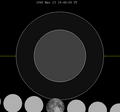 |
 |
 |
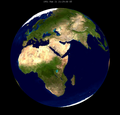 |
||||||
| 2027 Jul 18 (Saros 110) |
2038 Jun 17 (Saros 111) | ||||||||
 |
 |
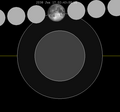 |
 | ||||||
| 2049 May 17 (Saros 112) |
2060 Apr 15 (Saros 113) |
2071 Mar 16 (Saros 114) |
2082 Feb 13 (Saros 115) |
2093 Jan 12 (Saros 116) | |||||
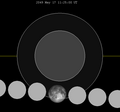 |
 |
||||||||
| 2103 Dec 13 (Saros 117) |
2114 Nov 12 (Saros 118) |
2125 Oct 12 (Saros 119) |
2136 Sep 10 (Saros 120) |
2147 Aug 11 (Saros 121) | |||||
| 2158 Jul 11 (Saros 122) |
2169 Jun 09 (Saros 123) |
2180 May 09 (Saros 124) |
2191 Apr 09 (Saros 125) | ||||||
Inex series
This eclipse is a part of the long period inex cycle, repeating at alternating nodes, every 358 synodic months (≈ 10,571.95 days, or 29 years minus 20 days). Their appearance and longitude are irregular due to a lack of synchronization with the anomalistic month (period of perigee). However, groupings of 3 inex cycles (≈ 87 years minus 2 months) comes close (≈ 1,151.02 anomalistic months), so eclipses are similar in these groupings.
| Series members between 1801 and 2200 | |||||
|---|---|---|---|---|---|
| 1824 Dec 06 (Saros 103) |
|||||
| 1969 Aug 27 (Saros 108) | |||||
 |
 | ||||
| 1998 Aug 08 (Saros 109) |
2027 Jul 18 (Saros 110) |
2056 Jun 27 (Saros 111) | |||
 |
 |
 |
 |
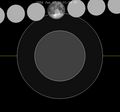 |
 |
| 2085 Jun 08 (Saros 112) |
2114 May 19 (Saros 113) |
2143 Apr 29 (Saros 114) | |||
| 2172 Apr 09 (Saros 115) | |||||
Half-Saros cycle
A lunar eclipse will be preceded and followed by solar eclipses by 9 years and 5.5 days (a half saros).[9] This lunar eclipse is related to two partial solar eclipses of Solar Saros 117.
| July 13, 2018 | July 23, 2036 |
|---|---|
 |
 |
See also
Notes
External links
Wikiwand - on
Seamless Wikipedia browsing. On steroids.
